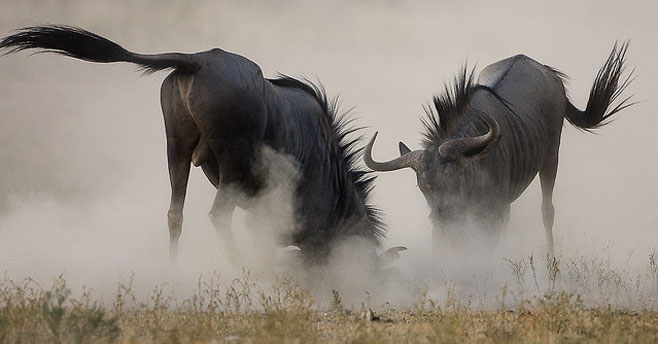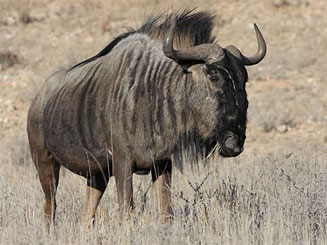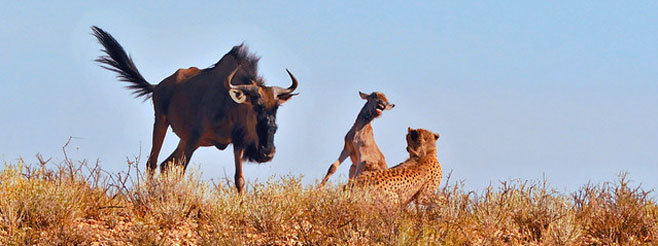|
Connochaetes taurinus (Blue wildebeest)
brindled gnu, brindled wildebeest
[English]; blouwildebees [Afrikaans]; Streifengnu [German]; gnou bleu, gnou a queue
noire [French]; nyumbu [Swahili]; inkonkoni, imbudumo, imbuduma ehlaza [isiNdebele]; inkonkoni [isiXhosa]; inkonkoni, inkonkoni enombala oluhlaza [isiZulu]; kgôkông [Sepedi]
[Setswana]; kgokong, kgaranyane [Sesotho]; ngongoni [Shona]; ingongoni, ngongoni [siSwati]; hongonyi
[Xitsonga]; khongoni, khongoini [Tshivenda]; kokonu [Lozi]; unzonzo [Yei]; Gaob [Nama]
[Damara]
Life
>
Eukaryotes >
Opisthokonta >
Metazoa (animals) > Bilateria > Deuterostomia >
Chordata > Craniata > Vertebrata (vertebrates) >
Gnathostomata (jawed vertebrates) > Teleostomi (teleost
fish) > Osteichthyes (bony fish) > Class:
Sarcopterygii (lobe-finned fish) > Stegocephalia
(terrestrial vertebrates) > Reptiliomorpha > Amniota >
Synapsida (mammal-like reptiles) > Therapsida > Theriodontia
> Cynodontia > Mammalia (mammals)
> Placentalia (placental mammals) >
Laurasiatheria > Ferungulata > Cetartiodactyla (even-toed ungulates and cetaceans)
> Ruminantia (ruminants) > Family:
Bovidae (antelopes and buffalo) > Subfamily: Antilopinae
 |
|
Blue wildebeest duelling, Kgalagadi Transfrontier
Park, South Africa. [photo Gerhard Theron ©] |
 |
 |
|
Blue wildebeest, Kgalagadi Transfrontier Park,
South Africa. [photo Trevor Hardaker ©] |
Blue wildebeest with calf, Kgalagadi Transfrontier
Park, South Africa. [photo Trevor Hardaker ©] |
Found in the savanna regions of southern Africa,
also with a large population in East Africa. Predominantly a grazer
of short green grass. They form large herds, especially when on
migration to better grazing grounds. In the breeding season the
males try (not always successfully) to hold a territory round their
cows, with cows and young in a territory numbering from 2 to 150.
Identification
A larger member of the antelopes the blue wildebeest coat
is brindled, dark grey tinged with brown streaks. It has a long black horse-like
tail. The shoulders are markedly higher and more robust than the rump, this
gives it an ungainly appearance. A dark mane runs from the shoulders to the top
of the neck, and a dark beard hangs from the chin to the chest. The head is
large with a broad snout, and the face is convex in shape and dark brown to
black in colour. Although much lighter the unridged horns are similar in shape
to those of the African buffalo, they form bosses at the bass and grow outwards
then turn sharply upwards and inwards. Cows have thinner more lightly built
horns than the bulls.
Size
Shoulder height 1.5 m; weight 250 kg; average horn
length 60 cm.
Dental Formula
I C C P P M M =
30 =
30
Distribution and habitat
Natural distribution extends over the northern regions of
southern African sub-region. There is a separate population in Kenya and
Tanzania. It prefers open grassland and savannah woodland with water and shade
available.
General behaviour
Wildebeest are gregarious with herds usually averaging
about 30 members. However, this species can gather in much larger concentration
numbering thousands of animals during migrations to new-feeding grounds. The
most well known example is the annual migration of thousands of blue wildebeest
in the Masai Mara, similar mass migrations take place in Botswana. However, the
smaller herds maintain their identity within the larger mass.
Blue wildebeest are active during the day but shelter in
shade during the hottest periods. They are also known to be active on moonlit
nights, but are not very active when it is dark. During the breeding season
bulls are territorial and try to defend a zone around their cows, with a
territory containing 2 – 150 cows and their young. However, cows move through
the territories and may mate with more than one bull. Outside the breeding
season the cows move freely. Bachelor herds are made up of bulls of all ages and
usually occur on the fringe of the main herd.
 |
|
Cheetah chasing down a Blue wildebeest calf, 20 km
north of Twee Rivieren, Kgalagadi National Park, South Africa. [photo
Callie de Wet ©]
|
 |
|
Blue wildebeest charging in to rescue its calf
from a Cheetah (evidently a different event to the one above), 30 km
north of Twee Rivieren, Kgalagadi National Park, South Africa. [photo
Callie de Wet ©]
|
Food
Predominantly a grazer of short green grass.
 |
|
Blue wildebeest herd grazing, Kgalagadi Transfrontier Park,
South Africa. [photo Trevor Hardaker ©] |
Reproduction
The gestation period is about 250 days. A single calf is
born usually during the middle of summer, it can move with the herd within 5
minutes of its birth. The calf is a lighter colour than the adults, more grey
brown, with a darker face and a dark vertical stripe. The calf will start to eat
grass after 2 weeks but suckles form its mother until about 8 months of age. The
calf is born with out horns, but has small straight divergent horns after 6
months. After about 16 month the characteristic is evident and the horns are
fully developed by the time the animal is 3 years old.
Life span
20 years (captivity)
Conservation
The mass migration of herds in Botswana has been curtailed
by the veterinary cordon fences and has disturbed the traditional routes. Now
animals are unable to follow grazing and water and they become trapped against
the fences unable to move through and unable to retreat. For this reason,
mortalities are much higher than they should be. The long term effect on the
population in this region is as yet unknown. Conservation status is regarded as
low risk, but the survival of the species is conservation dependant.
Text by Denise Hamerton
|
